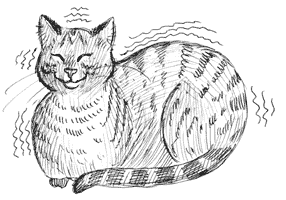>> Back to The HooK front page
STRANGE BUT TRUE- Happy cat?: Pain can prompt purring too
Published March 10, 2005 in issue 0410 of the Hook
By BILL SONES AND RICH SONES, PH.D.

DRAWING BY DEBORAH DERR McCLINTOCK
BY BILL SONES AND RICH SONES, PH.D.
Q. Has science figured out a cat's purr yet? --J. Fariello
A. Cats purr when "contented," but also when injured or in pain, says the online Mad Scientist Network. Maybe purring is a sort of mantra, "a relaxing, self-comforting sound and a friendly mood-conveying signal," says the Encyclopedia Britannica.
It's not exactly a vocalization (cats have many). Rather the vocal cords open and close 25 times per second or so, causing vibrations felt throughout the cat's body and the bodies of her snuggly kittens-- perhaps acting as a bond, suggests Tulane University biomedical engineer David Rice.
There's actually a "purring center" in the brain, activated by stress and other conditions. One may liken purring to smiling in humans: Usually we smile when happy, elaborates Rice, but we recognize the grimace of pain as well as the sardonic grin as conditions where the smile muscles are used for reasons other than happiness.
"Additional fun fact: The domestic cat can purr while vocalizing, giving its voice sound a whirring character," says Rice.
Q. From a rested reader: "Why does my buzz-saw snoring wake up my wife but not me?" --F. Zentz
A. Just as army infantrymen can sleep next to an 8-inch howitzer all night, the big guns booming out at 100-140 decibels (dB), yet an enemy rifle at 80 dB instantly awakens them, the snorer simply "tunes out" his own sound, says University of California-Irvine otolaryngologist and sleep disorders specialist Roger L. Crumley. Also, the snoring is often directed right at the spouse's ear, while the snorer's ears are behind the sound.
And since snoring occurs during a stage of deep, restful sleep, the sleeper's mind tags the sound as an "allowed intrusion," permitting him to keep on sleeping. No such benefit works on behalf of the spouse. Worse, after several nights, her affronted auditory system and nerves begin to "tune in" to the sound, much as a bothersome rooster or highway becomes almost impossible to ignore.
Maybe most important, says Crumley, two-thirds of loud snorers have sleep apnea, becoming chronically sleep deprived. "They need rest so badly that in early sleep stages a train could come through the bedroom without derailing their snoring."
Q. Where did "wind-chill" originate, and how dramatic are its effects? --S. Cheyne
A. While in Antarctica in 1941, U.S. explorer Paul Siple coined the term to describe wind-driven heat loss, says Frances Ashcroft in Life at the Extremes: The Science of Survival. He found that in still air at -29C there is little danger for a properly clothed person but with a wind of just 10 mph, the -29C acts more like -44C (-41C by a newer formula) and skin freezes within minutes.
When the thermometer drops really low, hands and feet may get sacrificed to freezing as the central body tries to stay warm for survival, says Ashcroft. Icy winds on the face may freeze the surface of the eyes and the lids. Most of the body can be protected by clothing, but too cold and dry and the air can destroy the cells of the respiratory tract, causing them to slough off and bring on suffocation.
In 1936, surgeon T.H. Somervell, who climbed Everest, described having a fit of coughing that dislodged something in his throat, which stuck, making it impossible to breathe: "I made one or two attempts," he said, "but nothing happened. Finally, I pressed my chest with both hands, gave one last almighty push-- and the obstruction came up."
Q. Curious question, but is your body symmetrical right to left? --V. Frankenstein
A. Your arms, hands, fingers, legs, feet, toes, eyes and ears show "bilateral symmetry," as do features like nose, chin, navel, says Martin Gardner in The Ambidextrous Universe. Inside you, too, symmetricality reigns, except for your heart, stomach and pancreas shifted left, liver and appendix to the right.
Only when considering bodily behaviors and functions does this mirrored bi-laterality break down, with most of us writing, shaving or throwing right-handed. Less well known is that right-handers usually are also right-footed, right-eye and right-ear dominant, and right-side chewers. When a right-hander carries something heavy, most often it'll be strapped over the left shoulder, leaving the right hand free.
Right- or left-handed, when you cross your arms, you'll cross them a certain way every time. Try crossing your arms naturally, then switching. The switch will feel weird.
Send Strange questions to brothers Bill and Rich at
.
#
>> Back to The HooK front page
|